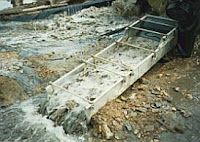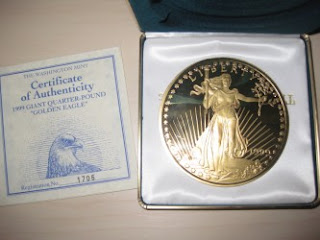If you've been reading my blog regularly you have probably figured out that I like not only gold, but also silver. I call this blog the
gold market because I see gold as something of a symbol of preserving your wealth against fiat currencies that are being devalued. But gold is not the only precious metal I invest in, and not the only commodity I invest in.

Right now we are in a commodities bull market that began in 1998 or 1999. The average length of a commodities bull market is 18 years, giving us plenty of more time to position ourselves to profit from it. Many think that the commodities bull market has ended, but what we are seeing is a mid-bull market correction. The current prices of commodities in general are extremely low, so now is an opportunity to buy.
I continue to buy gold, but during the current slump in commodities prices I am buying a lot more of other commodities than of gold. The main reason is simple: they have dropped in price while gold hasn't (speaking in general times). At the time of writing, gold is trading at $887.48 per troy oz. That is about the same as June of last year. Compare that to the Reuters-CRB Index (CRB stands for Commodities Research Bureau) that tracks the price of commodities in general, is way down, around 40% down. This is because of reduced economic activity as a result of the global economic recession. Gold has held relatively steady during this time as it is seen as a safe haven during economic crisis. So even though gold has dropped down from its highs, it is not as good of a buying opportunity as other commodities right now. In fact, when economic activity starts picking up again I think that gold will initially drop because it will lose some of its safe haven image, and we'll have a better buying opportunity at that time. Gold will continue to go up much higher when people realize how much the government has debased the currency, but this will be later on. Right now other commodities are cheaper and offer better opportunities for gains.

So what am I buying? Well, of course I love silver, because it has many of the benefits of gold as "real money" that can not be debased, but it is also much more of an industrial metal than gold. That's why the current industrial slowdown offers a great buying opportunity for silver. There is also a lot of data to show that silver supplies are much more limited than most people are aware of, and when shortages become apparent, the prices will skyrocket like crazy in the coming years. I am snatching up as much physical silver as I can afford to buy.
But I am also putting money into a diversified commodities futures fund, so that I can invest in commodities in general. This fund allows the managers to both short and long different commodities, so it normally goes up even when commodities have dropped, because the managers are shorting commodities. But due to the extra risk in that (they could make a bad trade) I chose a fund that deals only in cash and does not use leverage. Some funds that use leverage get hit very hard when they make some bad trades.
You can also invest in a simple commodities index tracker fund that involves no shorting. I would probably invest in one of these, but I don't have access to a good one where I currently live.
I am also putting money into an energy fund that invests mainly in oil companies. This one is a bit of a wildcard and I expect to sit on this for a while until oil reaches over $100 a barrel again, and then I'll sell it. I'm doing this as an opportunity to learn more about energy, so I can't really put my full weight behind this yet.
I also have a significant chunk of my savings in Australian dollars and Canadian dollars, since those are resource rich nations whose economies in general and currencies will benefit from the rise in commodities prices. I like investing in commodities currencies because I can buy and sell them very easily through online banking. I can sell them at a moment's notice. And the only fees are the buy/sell spread in the exchange rate. Easy. The only problem with currencies is that they can and will fluctuate like crazy in the short term, so I only put in money that I won't need until I'm ready to cash out further along in the bull market.
Those are my current interests, based on the low price of commodities. Commodities provide opportunities for exponential growth from their current levels. I expect that gold will initially drop as they rise. When that happens I will buy more gold, which I think will explode when the degree of currency inflation becomes apparent. Gold is the ultimate safe haven and preserver of your wealth, but commodities in general offer amazing opportunities at the moment.
For historical commodity price data, try
here.












